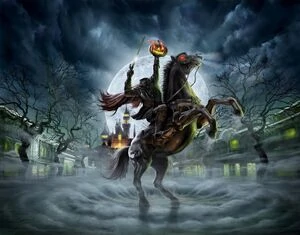
The Headless Horseman is a legendary ghost, who appears in Washington Irving's 1820 Horror short-story The Legend of Sleepy Hollow. Since then, the Horseman has appeared in many movie adaptations. The most wildly excepted image of this ghostly figure is a man dressed in black who rides atop a black horse and carries a jack-o'-lantern under his arm which serves as his primary weapon though he can also be seen carrying an axe or sword.
The Headless Horseman of Sleepy Hollow[]
The Headless Horseman of Sleepy Hollow is a monster inspired by the Dullahan legend who appears in Washington Irving's 1820 Gothic short-story The Legend of Sleepy Hollow. In this story which is arguable the most famous incarnation of the Dullahan legend, the Headless Horseman is a ghost rather than a faery.
In the backstory given to the story, the Headless Horseman was a Hessian horseman (likely a mercenary) who fought for the British during the American Revolutionary War. The Horseman was killed in 1776 at the Battle of White-Plains (although the book refers to it as "Some nameless battle") when his head was blasted off of his shoulders by a cannon-ball. They buried the body of the horseman in the graveyard of the Old Dutch Church outside a small dutch-colonized village called Sleepy Hollow (or "Tarrytown" in real life). According to the folklore of Sleepy Hollow, the ghost of the horseman emerges from his tomb at night and rides through the woods in search of his head own head or at the least, a new one.
According to legend, the Headless Horseman rises every night searching for his head, and if not, he would take someone else's. Ichabod Crane, Sleepy Hollow's school teacher, was first introduced to the legend when Brom Bones told everyone at Baltus van Tassel's Halloween party about the Horseman. That night, when Ichabod traveled back to Sleepy Hollow, he has a terrifying encounter with the Headless Horseman, resulting in the Horseman throwing his pumpkin head at Ichabod. What happened to Ichabod is unknown; he may have survived, or the Headless Horseman took his head. However, Brom Bones was the one behind Ichabod's chase and the legend itself. Ichabod's whereabouts following the event have remained a mystery.
The Headless Horseman's relationship with Halloween[]
The Headless Horseman is infamously known for his ascent to the mortal plane on Halloween, searching for his lost decapitated head and would kill anyone who so foolishly cross his path and take their heads as his own.
The Headless Horseman is traditionally depicted as a man upon horseback who is missing his head. Depending on the legend, the Horseman is either carrying his head, or is missing his head altogether, and is searching for it.
The legend of the Headless Horseman (also known as "the Headless Hessian of the Hollow") begins in Sleepy Hollow, New York, during the American Revolutionary War. Traditional folklore holds that the Horseman was a Hessian trooper who was killed during the Battle of White Plains in 1776.
He was decapitated by an American cannonball, and the shattered remains of his head were left on the battlefield while his comrades hastily carried his body away. Eventually they buried him in the cemetery of the Old Dutch Church of Sleepy Hollow, from which he rises as a malevolent ghost, furiously seeking his lost head. Modern versions of the story refer his rides to Halloween, around which time the battle took place.
